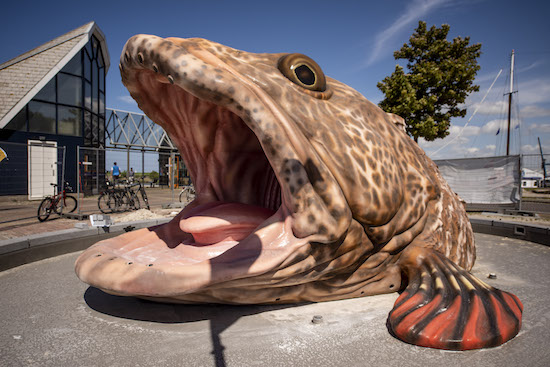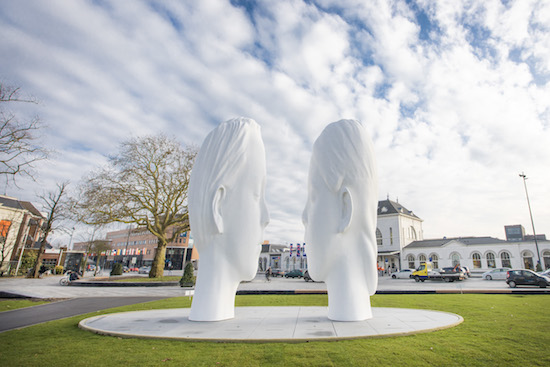11Fountains – Leeuwarden © IMAZZO, Leeuwarden-Friesland
What is left that speaks of uniqueness through these places in which we pass, at a time in which our borders that are becoming increasingly segregated and politics speaks openly of hostilities. In this climate, our culture, history, food and hospitality to others matters, yet how do we talk about these subjects without flattening them. The distinctive qualities that define the regions that we inhabit have emerged from the communities that embodied them, focussed through time, discussion and economics, they have weathered uncertainty and conflict and exist in the present as regularly encountered tropes. They form deserves to be represented, celebrated and shared with others through a sense of the civic and belonging. A celebration requires a structure. Here, the European Capital of Culture (a project that took form in 1985), directly engages these humanistic activities. A competition constituted to highlight the richness of the winning city’s cultural diversity, that requires an exploration of dialogue and the creation of an offer of curated events that seek to prompt tourism and exchange.
In 2018 Leeuwarden-Friesland shares the title of European Capital of Culture with Valleta. A moment in the spotlight in which they will occupy a new lens in the eyes of their inhabitants and take on a visibility that promises transformation, regeneration and enhancement.
Yet these aspects of cities that cite a unique authenticity exist within a climate of global warming, referendums, repeals and plastic pollution. In Leeuwarden-Friesland a coastal province in which large amounts of land mass exist below water level, water is not only a life force but a potential enemy. The communities that live in the eleven Frisian cities are linked by canals, that form the historic Elfstedentocht skating track. Last skated in 1997 the warmer winter climate has now rendered the ice brittle and has created a space for a new narrative to emerge.
Artistic director Anna Tilroe has reimagined Elfstedentocht as a project in which eleven contemporary international artists link the historic cities through fountains that could touch the life environment of the residents and talk to newcomers of the strengths of these individual communities. She was aware of the deep need to connect this project with the populations of the cities and asked the artists involved to engage beyond the immediate through connection with residents. To achieve this aim, individual fountain committees were made in each city to broker conversations with artists and work as both commissioners, advisors and companions through the creation of the work.
Within our cities the square is a contested space, at risk of losing its civic function to car parking and commerce. For Birthe Leemeijer – as with Jorge & Lucy Orta – the fountain is a way of protecting and renewing these spaces and their potential for sociability. Sloten Jorge & Lucy Orta’s fountain, The Lapwing of Sloten, is set within a small square ringed with shops. On one side, the road leads to a picturesque canal. On the other is a factory – a place of work for the majority of people living nearby. The sculpture and the space it commands has been refreshed and is now shared with both residents and visitors. The work speaks of water scarcity, from a stack of water containers encountered by the artists through their work in the city, trickles of water flow naturally and without pomp. On these water cans stands a boy. On his shoulders is a girl holding a Lapwing, a native species to Friesland whose existence has been endangered by agricultural farming, hidden from sight in its beak is a key, a symbol of the community of the city.
Birthe Leemeijer has extended the remit of the fountain and has created a town square, that could hold not only the work The Ice fountain of Dokkum (inspired by an archival photo taken by Erik Koch in 1963 of the frozen North Sea) but also encapsulate the planting of swamp oaks that form a bond to the to the cutting down of the Sacred Oak once worshipped by the pagans of Friesland. This is an act that seeks to repair a disconnect with nature that was formed through conversation with residents. Birthe felt this dialogue intergral to the future of the work:
“I was very closely involved in this whole discussion and exchange with the people who are living there, because for us its very important that the people come and use the public space in the way that they wish and desire. It’s very important that we speak about all of the layers beneath us, and what layers mean for the people now, and also what it means to be here in the twenty-first century after St. Boniface cut down the oak.”
The ideas that formed the The sperm whale of Harlingen by Jennifer Allora & Guillermo Calzadilla were made in response to histories of whaling within the city and the transference of this marine mammal from a hunted source of income to protected creatures that are rescued when adrift. The whale (a symbolic form) also reveals the increasing transience and fluctuations of the tides, sited in Harlingen’s harbour. It is a measuring device. For Jennifer:
“The harbour is subject to very extreme fluctuations in its tide, the tide goes up twelve feet and down again twice a day. So there will be many times the object will be completely formless, invisible, not there, not visible. There will be other times when the tide goes away and the form reveals itself, so there’s a push and pull between abstraction and representation. That happens on the condition of the natural phenomenon of the tides.”

Stavoren – Mark Dion – De Visfontein voor Stavoren ©
For Mark Dion, building a fountain became a rich source of questions on the present and past of public art. He sees this traditional form like a fountain as an opportunity to consider how we move “forward in terms of strategy and public art”. For Dion, the fountain is also a place of celebration:
”When I think of fountains, I think of delight, I think of pleasure, I think of the opportunity for interaction. So for me it was an interesting challenge to use my own concerns and thematics, to make something that has a lighter way to interact with it.”
His work The fish of Stavoren manifests as a gargantuan beast of the sea, referencing Big Fish Eat Little Fish by Pieter Bruegel the Elder it has emerged as if from the depths of the sea into the harbour of Stavoren, enticing the foolhardy to walk into its gaping jaws. Manufactured by Ron Holthuysen, it communicates the sheer oddity and unknowability of ocean life.
The 11 Fountains are newly born in their environments. At the time I visited their bases were still being amended and installed, cut turf ran over concrete and water channels tested. The fountains felt as glossy as new foals and their sense of newness resting in these places of tradition created static. For all of the debates held over the 11 Fountains’ acceptance by the residents of each of the cities of Friesland, it is relevant to ask who would ever want public art that is just benign to its environment? Who needs a public art that is merely good, never treads on toes or disrupts how a site is encountered?
Cornelia Parker’s work The lions of Workum has taken two heraldic lions out of their context of the Waaggebouw (weigh house) in Workum. Released from their duties of holding the the cities shield they now act as frames through which the everyday can be seen and life can pass. Playful in their newfound environment they were carved from Accoya wood by a local artist Floor van der Leun. Hidden inside them are letters from the school children of Workum that contain wishes for the future.
The world is full of public sculptures whose time has passed, giant cogs of industry hidden under motorway bridges, abstract imaginings of the future demoted to unloved corners of public squares or resting out of context like the statues of Lenin, Marx, Engels re-sited in Budapest’s Memento Park. 11 Fountains create a place that is shared. They undercut the uniform density of public sculpture with their connection to the civic and the sheer sense of joy that is created through the theatrics of moving water. Over time the works will weather, they will become part of the everyday, and new narratives will grow on them like moss, as the sense of achievement that each fountain committee shares with the artists they created the work with spreads outward.
11 Fountains goes beyond public works that are designed as a spectacle and dropped into a site. These are places of the future, they are rich with the dialogues and encounters that formed them and add texture to the locations they are placed within. Adding a new narrative to their sites, they will be climbed, become meeting points, and act as nodes that can speak of the complexity of water within a shifting present. Let’s welcome them.


